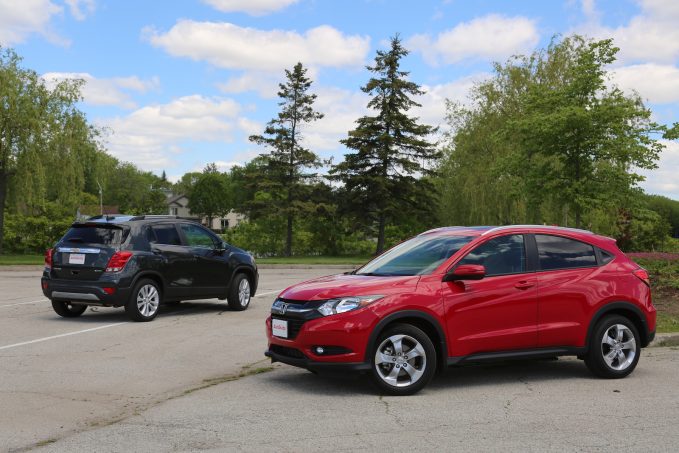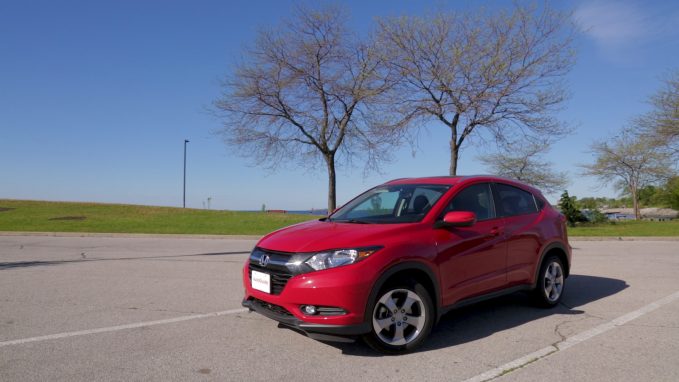GM helped popularize the subcompact crossover segment with the Buick Encore, so it makes sense that the Chevrolet Trax should be a strong contender in its field just based on its heritage. And for 2017, the Trax gets new styling that takes it from sleepy to sleek.
Honda, on the other hand, took its time getting into this market of small cars on stilts, releasing the HR-V in 2015. But the Japanese brand did its homework, releasing a small crossover with big numbers where it counts.
Sizing
In the backseat, Honda offers passengers 39.3 inches of legroom, where passengers in the Trax get 35.7 inches. Moving back, the Trax is also smaller, offering 18.7 cubic feet of storage space compared to the Honda’s 23.2 cubic feet. And what’s more, the backseat in the Trax has seat bottoms that fold forward to allow the seat back to fold down, resulting in a sloping load floor.
Get the Flash Player to see this player.
Honda’s so-called magic seats are one of the best solutions in the business, offering the classic seat backs folded down configuration (with a totally flat floor), along with seat bottoms that fold upwards, offering you tons of space for cargo on the floor, especially good for tall cargo.
So the Trax has less physical space than the HR-V, but here’s where the numbers don’t tell the full story. Thanks to its tall, bubbly roof and tall glass, the cabin in the Trax feels airy and gives the feeling of more space. On the flip side, the HR-V has a hard rake in the windshield and a slope in the rear roofline that makes the cabin feel cramped with little headroom to speak of. Honda wins in the size department, but it sure doesn’t feel like it, unless you sit in the back seats. Then it is painfully obvious to any full-size adult that the Honda’s legroom is generous compared to the cramped Trax.
Power
Honda and Chevy take different approaches to powering their small crossovers, with Honda opting for natural aspiration and a CVT, while Chevy goes for turbocharging and a six-speed automatic transmission.
Chevy offers a 1.4-liter turbocharged four-cylinder engine that makes 138 hp and 148 lb-ft of torque, while Honda has a 1.8-liter four-cylinder that makes 141 hp and 127 lb-ft of torque. What’s more important than those numbers is where each engine makes its power. Thanks to the turbo, all 148 lb-ft of torque in the Trax are available down low at just 1,850 rpm, leading to strong pull off the line, unlike the HR-V, which makes peak torque up at 4,300 rpm. And although its CVT is fairly responsive, and can even mimic gear shifts with paddle shifters, the HR-V never feels quick, just slowly and steadily getting up to speed.
ALSO SEE: 2018 Toyota C-HR vs 2017 Honda HR-V Comparison
If you can live without the quicker powertrain though, the advantage is increased fuel economy. The all-wheel-drive Honda HR-V is rated at 27 mpg in the city, 31 on the highway and 29 mpg combined, while the Trax returns 24 mpg in the city and 30 on the highway with all-wheel drive.
Driving these two further differentiates them, and both of them drive exactly how they look. The Trax appears tall and drives tall, flopping through corners with excess body roll and vague steering. On the other hand, the Honda has more sleek, low-profile look and accordingly it drives nice and tight, sticking in corners and providing solid feedback to the driver.
The Honda has a way of feeling better put together and better dialled in where the Chevy just feels sort of loose and sloppy.
Compare Specs
Inside
On the inside, the Chevy Trax delivers a nice dose of style with its curved lines and chrome trim, while the Honda appears more straightforward and focused on function rather than looks. Some of the HR-V’s features also point towards this focus on function, like the Brake Hold button which will hold the car at a stop light without the need for the driver’s foot to be on the brake pedal, or Honda’s LaneWatch camera that shows you what is in the lane to your right beside your vehicle when you signal a lane change to the right.
ALSO SEE: 8 Nissan Rogue Sport Specs You Need to Know
Over in the Chevy, you do get Android Auto and Apple CarPlay, both of which can’t be had in the Honda, though that is the only technology advantage you’ll find from the GM. And it is also slightly limiting, as you can’t get navigation in a Trax without using one of these systems, which depend on a smartphone.
In terms of actual functionality, the Trax’s infotainment system is simple to use and responds quickly, where the HR-V is slightly slower and more complicated.
Pricing
Price point is another big part of the story with these two vehicles. In the US, the Chevy Trax starts at $21,895 while our fully loaded Premier all-wheel drive version sells for $28,495. On both ends of the spectrum, Honda charges less, with the HR-V starting at $19,465 and climbing up to $26,240 for our fully loaded EX-L Navi model.
In Canada, the Trax is actually a little more competitive than in the States. The basic Honda HR-V starts at $23,247, while a loaded-up EX-L Navi model will sell for $32,547. Over at Chevy, the Trax starts at $24,895, while a fully loaded Premier version is slightly cheaper than the HR-V at $32,295.
The Verdict: 2017 Chevrolet Trax vs 2017 Honda HR-V Comparison Test
It’s clear that Honda did its homework before diving into this segment and the brand is once again showing its commitment to practicality with a small car that packs big interior dimensions. Combine that larger size with better fuel economy and a cheaper price, and it’s hard not to choose the Honda HR-V over the Chevrolet Trax.










